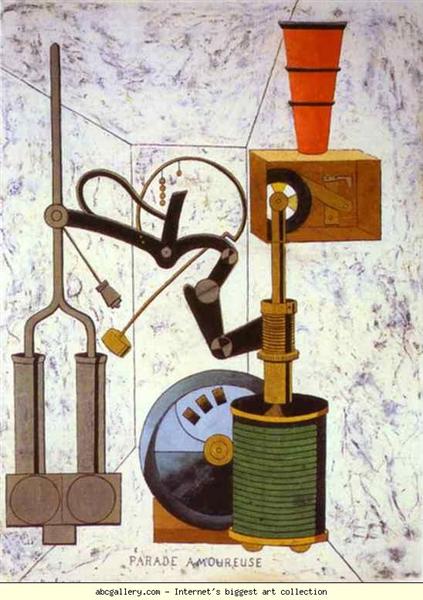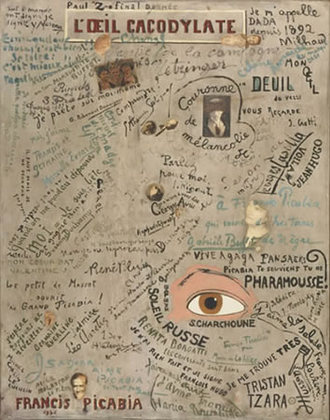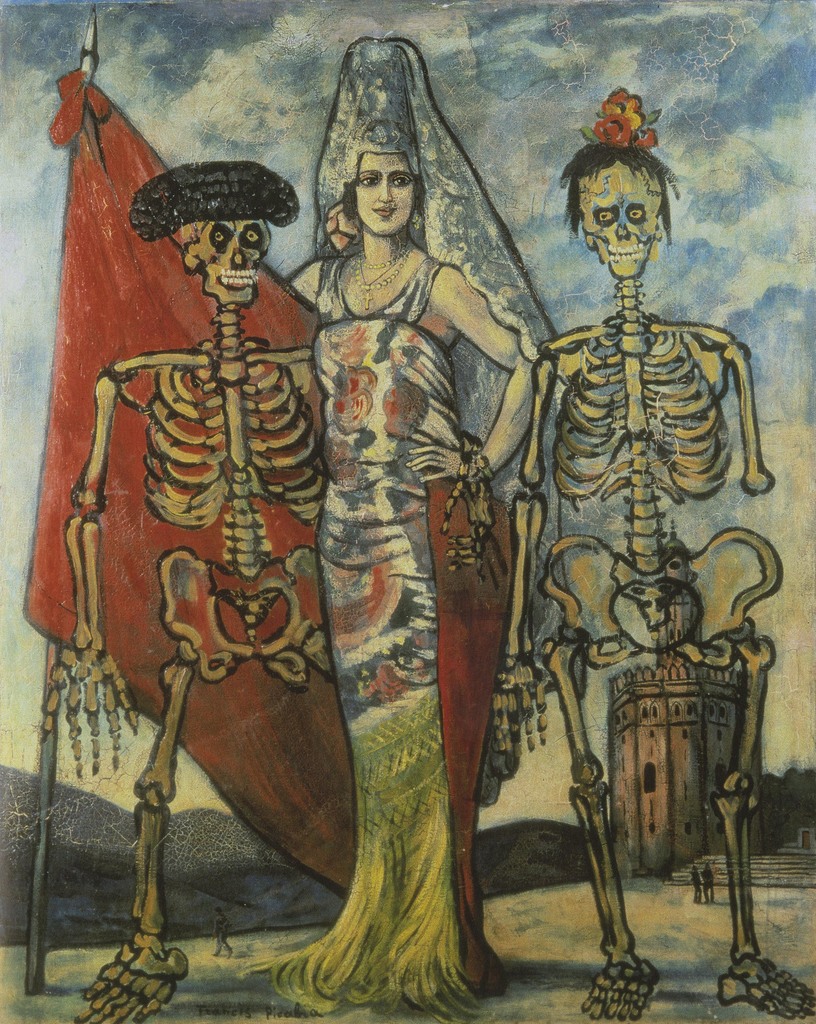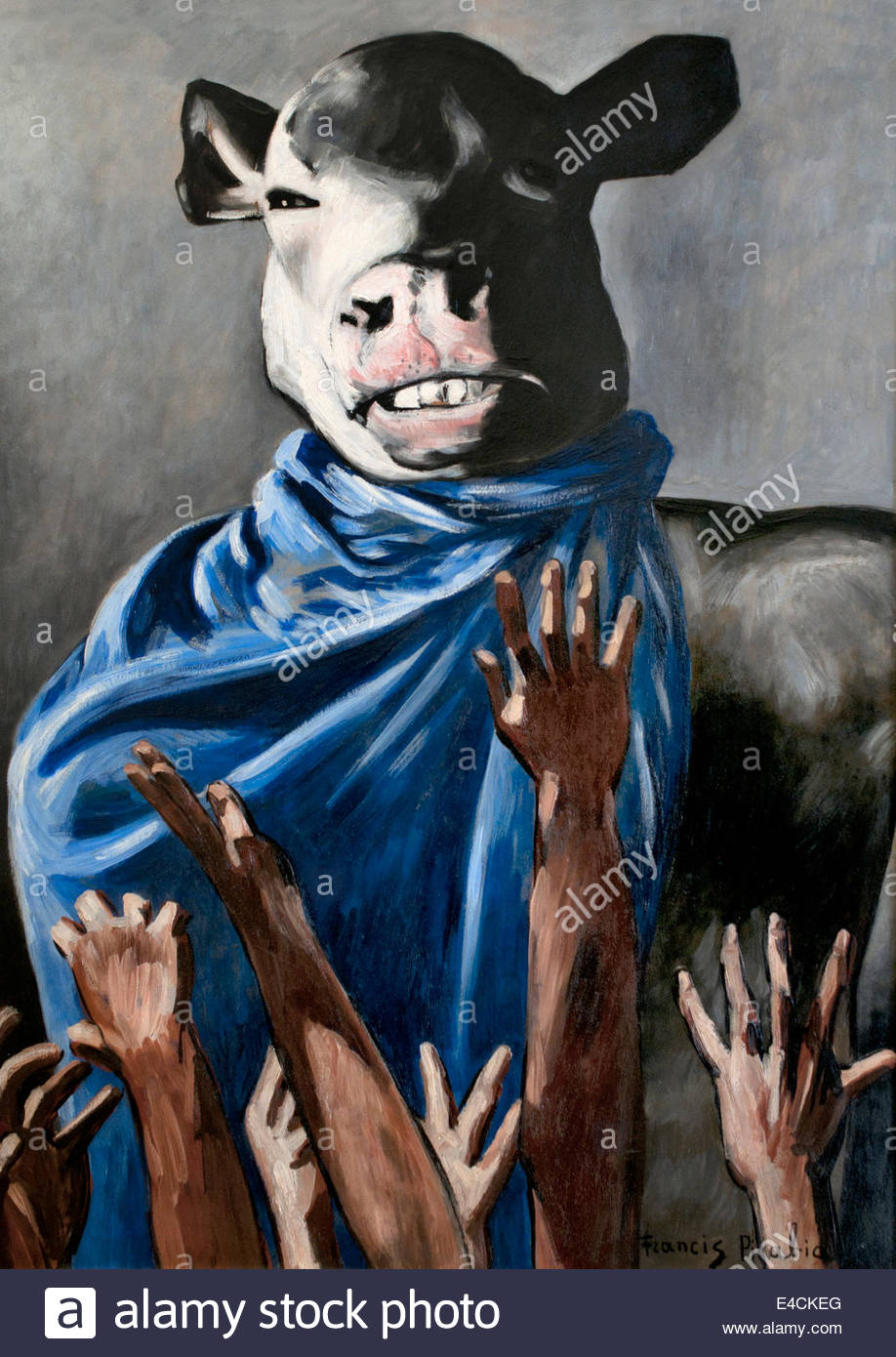Museum of Modern Art
November 21, 2016–March 19, 2017
Francis Picabia: Our Heads Are Round so Our Thoughts Can Change Direction is the first major exhibition in the U.S. to encompass the full range of Picabia’s audacious, provocative, and profoundly influential career. MoMA’s first-ever monographic exhibition of the artist, Francis Picabia brings together some 200 works in multiple mediums to explore the artist’s critical place in the history of 20th-century art.
Among the great modern artists, Francis Picabia (French, 1879–1953) remains one of the most elusive; he vigorously avoided any one singular style or medium, and his work encompassed painting, performance, poetry, publishing, and film. Though he is best known as one of the leaders of the Dada movement, his career ranged widely—and wildly—from Impressionism to radical abstraction, from Dadaist provocation to pseudo-classicism, and from photo-based realism to art informel. Picabia’s contributions to a diverse range of artistic mediums, along with his consistent inconsistencies, make him especially relevant for contemporary artists, and his career as a whole challenges familiar narratives of modernism.
Francis Picabia—conceived in partnership with the Kunsthaus Zürich, where its presentation is scheduled to coincide with the 100th anniversary of the founding of the Cabaret Voltaire, in 1916—assembles key selections and bodies of work, ranging in date from the first decade of the 20th century through the early 1950s. Picabia’s work as a painter—albeit one whose oeuvre consistently contests the term—will be represented, along with his activities as a publisher and contributor to vanguard journals, and his forays into screenwriting and theater. The core of the exhibition comprises some 125 paintings, along with approximately 45 key works on paper, one film, and a carefully chosen selection of printed matter.
Francis Picabia: Our Heads Are Round so Our Thoughts Can Change Direction is organized by The Museum of Modern Art, New York, and the Kunsthaus Zürich.
Organized by Anne Umland, The Blanchette Hooker Rockefeller Curator of Painting and Sculpture, The Museum of Modern Art, and Cathérine Hug, Curator, Kunsthaus Zürich; with Talia Kwartler, Curatorial Assistant, Department of Painting and Sculpture, MoMA.
Excellent review
Francis Picabia. Adam et Ève (Adam and Eve). 1911. Oil on canvas, 39 3/8 × 31 7/8″ (100 × 81 cm). Private collection. © 2016 Artist Rights Society (ARS), New York/ADAGP, Paris
Francis Picabia. Udnie (Jeune fille américaine; danse) (Udnie [Young American Girl; Dance]). 1913. Oil on canvas, 9′ 6 3/16″ × 9′ 10 1/8″ (290 × 300 cm). Centre Pompidou, Musée national d’art moderne – Centre de création industrielle, Paris. Purchased by the State, 1948. © 2016 Artist Rights Society (ARS), New York/ADAGP, Paris. Photo: © Centre Pompidou, MNAM-CCI/Georges Meguerdtchian/Dist. RMN–Grand Palais/Art Resource, New York.
Francis Picabia (French, 1879–1953). Je revois en souvenir ma chère Udnie (I See Again in Memory My Dear Udnie). 1914. Oil on canvas, 8′ 2 1/2″ x 6′ 6 1/4″ (250.2 x 198.8 cm). The Museum of Modern Art, New York. Hillman Periodicals Fund. © 2016 Artists Rights Society (ARS), New York/ADAGP, Paris. Photo: The Museum of Modern Art, John Wronn
Francis Picabia (French, 1879–1953). Très rare tableau sur la terre (Very Rare Picture on the Earth). 1915. Oil, metallic paint, pencil, and ink on board, with gold and silver leaf on wood, in a wood frame possibly constructed by the artist, 49 5/8 x 38 9/16 x 2 3/16″ (126 x 98 x 5.5 cm), with frame. The Solomon R. Guggenheim Foundation. Peggy Guggenheim Collection, Venice, 1976. © 2016 Artists Rights Society (ARS), New York/ADAGP, Paris
Francis Picabia. Parade amoureuse (Amorous Parade). 1917. Oil, gesso, metallic pigment, ink, gold leaf, pencil, and crayon on board, 38 × 29″ (96.5 × 73.7 cm). Neumann Family Collection. © 2016 Artist Rights Society (ARS), New York/ADAGP, Paris. Photo: Tom Powel Imaging
Francis Picabia (French, 1879–1953). L’Œil cacodylate (The Cacodylic Eye). 1921. Oil, enamel paint, gelatin silver prints, postcard, and cut-and-pasted printed papers on canvas, 58 1/2 x 46 1/4″ (148.6 x 117.4 cm). Centre Pompidou, Musée national d’art moderne – Centre de création industrielle, Paris. Purchase in honor of the era of Le Bœuf sur le Toit, 1967. © 2016 Artist Rights Society (ARS), New York/ADAGP, Paris. Photo: © Centre Pompidou, MNAM-CCI/Georges Meguerdtchian/Dist. RMN–Grand Palais/Art Resource, New York.
Francis Picabia. Optophone [I]. 1922. Ink, watercolor, and pencil on board, 28 3/8 × 23 5/8″ (72 × 60 cm). Kravis Collection. © 2016 Artist Rights Society (ARS), New York/ADAGP, Paris. Photo: The Museum of Modern Art, John Wronn
Francis Picabia (French, 1879–1953). La Nuit espagnole (The Spanish Night). 1922. Enamel paint on canvas, 63 x 51 3/16″ (160 x 130 cm). Museum Ludwig, Cologne. Ludwig Collection. © 2016 Artists Rights Society (ARS), New York/ADAGP, Paris. Photo: © Rheinisches Bildarchiv Köln
Francis Picabia. Espagnole (Espagnole à la cigarette) (Spanish Woman [Spanish Woman with Cigarette]). 1922. Watercolor, gouache, and pencil on paper, 28 3/8 × 20 1/16″ (72 × 51 cm). Private collection. © 2016 Artist Rights Society (ARS), New York/ADAGP, Paris. Photo courtesy Mercatorfonds
Francis Picabia (French, 1879–1953). Promenade des Anglais (Midi). c. 1924–25. Oil, enamel paint, feathers, pasta, and leather on canvas, in a frame by Pierre Legrain, 30 x 52 1/2 x 6″ (76.2 x 133.4 x 15.2 cm), with frame. Yale University Art Gallery. Gift of Collection Société Anonyme. © 2016 Artists Rights Society (ARS), New York/ADAGP, Paris
Francis Picabia (French, 1879–1953). Les Amoureux (Après la pluie) (The Lovers [After the Rain]). 1925. Enamel paint and oil on canvas, 45 11/16 x 45 1/4″ (116 x 115 cm). Musée d’Art moderne de la Ville de Paris. © 2016 Artists Rights Society (ARS), New York/ADAGP, Paris. Photo: © Musée d’Art Moderne/Roger-Viollet
Francis Picabia. Idylle (Idyll). c. 1925–27. Oil and enamel paint on wood, in a frame by Pierre Legrain, 44 5/16 × 32 1/2 × 2 15/16″ (112.5 × 82.5 × 7.5 cm), with frame. Musée de Grenoble. Gitt of Jacques Doucet, 1931. © 2016 Artist Rights Society (ARS), New York/ADAGP, Paris. Photo: © Musée de Grenoble
Francis Picabia. Untitled (Espagnole et agneau de l’apocalypse [Spanish Woman and Lamb of the Apocalypse]). 1927/1928. Watercolor, gouache, ink, and pencil on paper, 25 9/16 × 19 11/16″ (65 × 50 cm). Private collection. © 2016 Artist Rights Society (ARS), New York/ADAGP, Paris. Photo: Stephan Wyckoff
Francis Picabia. Aello. 1930. Oil on canvas, 66 9/16 × 66 9/16″ (169 × 169 cm). Private collection. © 2016 Artist Rights Society (ARS), New York/ADAGP, Paris
Francis Picabia. La Révolution espagnole (The Spanish Revolution). 1937. Oil on canvas, 63 3/4 × 51 3/16″ (162 × 130 cm). Private collection. Courtesy Thomas Ammann Fine Art AG, Zurich. © 2016 Artist Rights Society (ARS), New York/ADAGP, Paris. Photo courtesy Archives Comité Picabia
Francis Picabia. Le Clown Fratellini (Fratellini Clown). 1937–38. Oil on canvas, 36 1/4 × 28 3/4″ (92 × 73 cm). Private collection. © 2016 Artist Rights Society (ARS), New York/ADAGP, Paris
Francis Picabia (French, 1879–1953). Têtes superposées (Superimposed Heads). 1938. Oil on wood, 28 3/4 x 24 13/16″ (73 x 63 cm). Private collection. © 2016 Artists Rights Society (ARS), New York/ADAGP, Paris
Francis Picabia (French, 1879–1953). Femmes au bull-dog (Women with Bulldog). c. 1941. Oil on board, 41 3/4 x 29 15/16″ (106 x 76 cm). Centre Pompidou, Musée national d’art moderne – Centre de création industrielle, Paris. Purchase from a public sale, 2003. © 2016 Artist Rights Society (ARS), New York/ADAGP, Paris. Photo: © Centre Pompidou, MNAM-CCI/Jean-Claude Planchet/Dist. RMN–Grand Palais/Art Resource, New York.
Francis Picabia. L’Adoration du veau (The Adoration of the Calf). 1941–42. Oil on board, 41 3/4 × 30″ (106 × 76.2 cm). Centre Pompidou, Musée national d’art moderne – Centre de création industrielle, Paris. Purchase with assistance from the Fonds du Patromonie, the Clarence Westbury Foundation, and the Societé des Amis du Musée national d’art moderne, 2007. © 2016 Artist Rights Society (ARS), New York/ADAGP, Paris. Photo: © Centre Pompidou, MNAM-CCI/Philippe Migeat/Dist. RMN–Grand Palais/Art Resource, New York.
Francis Picabia (French, 1879–1953). Danger de la force (Danger of Strength). 1947–50. Oil on canvas, 45 1/2 x 35 1/16″ (115.5 x 89 cm). Museum Boijmans Van Beuningen, Rotterdam. © 2016 Artists Rights Society (ARS), New York/ADAGP, Paris. Photo: Studio Tomp, Rotterdam
Francis Picabia. Haschich (Hashish). 1948. Oil on canvas, 45 11/16 × 34 5/8″ (116 × 88 cm). Friedrich Christian Flick Collection. © 2016 Artist Rights Society (ARS), New York/ADAGP, Paris. Photo courtesy Archives Comité Picabia




















